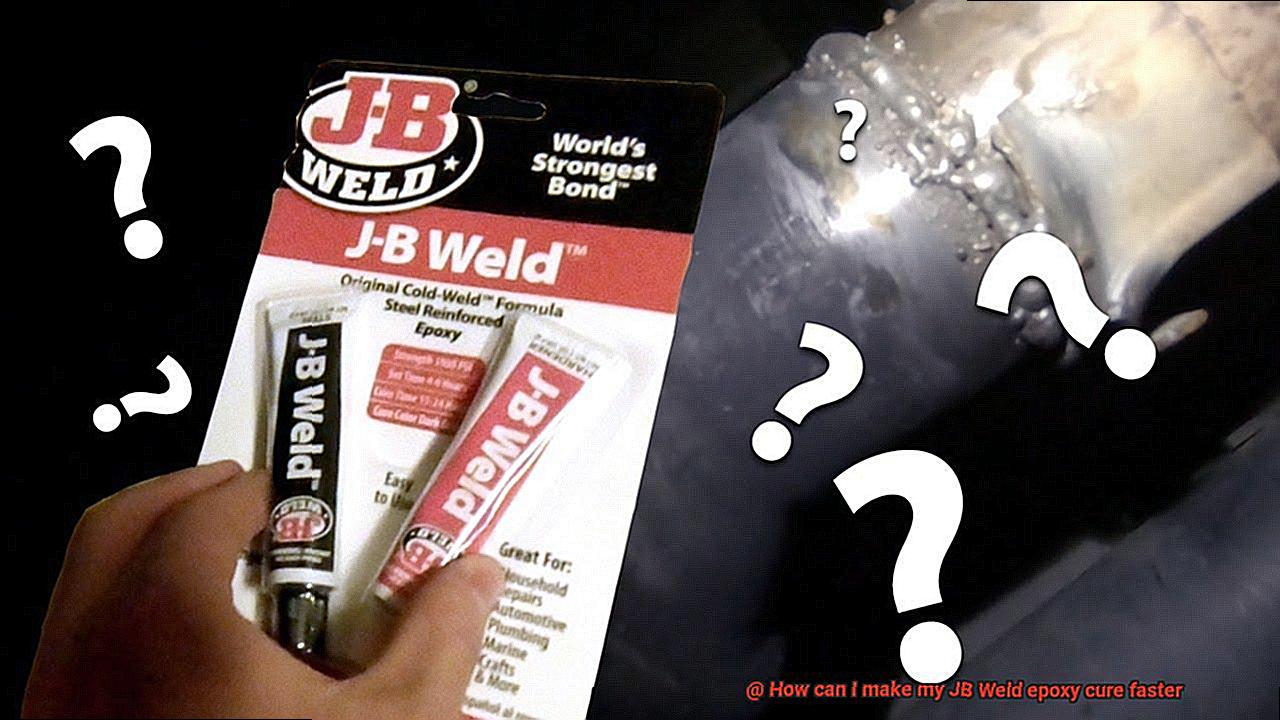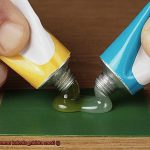You’ve found yourself knee-deep in a DIY project, only to discover that your JB Weld epoxy adhesive is taking its sweet time to cure. Waiting around for it to fully set can be a real buzzkill, especially when you’re itching to move forward with your masterpiece. But fret not, my friend, because I’ve got some killer tips and tricks up my sleeve to help you speed up that curing process.
In this blog post, we’re going to dive headfirst into the world of turbo-charged epoxy curing. From simple yet effective techniques to some nifty tools, we’ll make sure that your JB Weld epoxy cures faster than a cheetah on roller skates. So buckle up and get ready to rev those engines – it’s time to make things happen.
Preparing the Surface:
First things first – let’s get those surfaces prepped and primed for action. Before applying the epoxy, make sure they’re squeaky clean, bone-dry, and free from any pesky dirt or grime. Whip out some acetone or rubbing alcohol and give ’em a good scrub. Trust me, this little step will work wonders in helping the adhesive stick better and kickstart that speedy curing process.
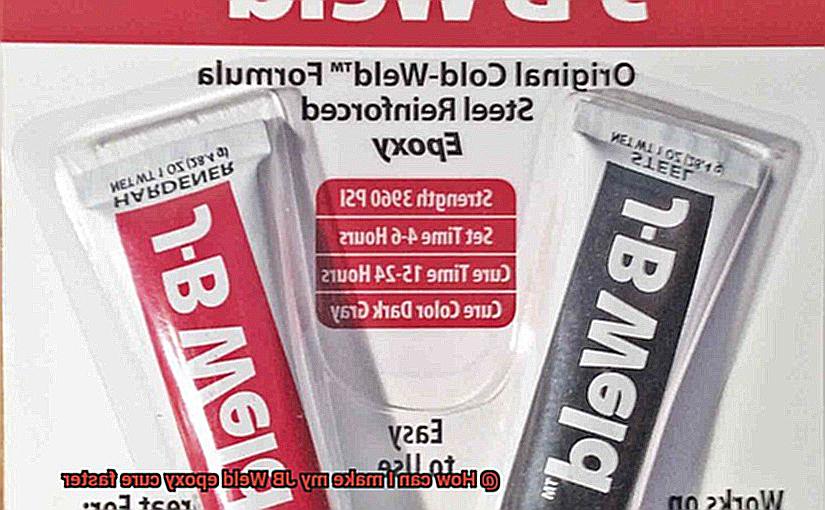
Mixing and Ratio Accuracy:
Now let’s talk about mixing things up…literally. When it comes to combining your JB Weld epoxy components, precision is key. Follow those instructions like they’re the holy grail of DIY wisdom. Mix ’em up on a flat surface until they become one harmonious blend of awesomeness. Remember, a well-mixed epoxy means faster curing and a bond so strong it could lift weights at the gym.
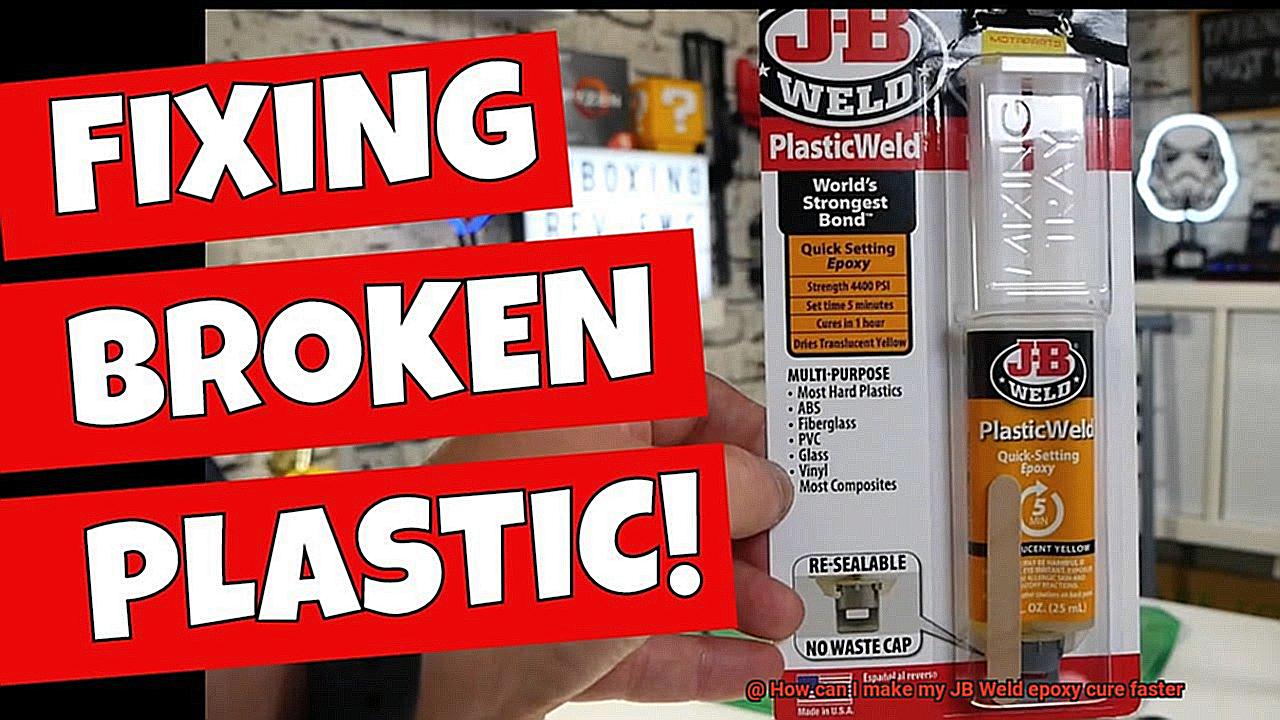
Temperature Considerations:
Time to crank up the heat. Well, figuratively speaking at least. You see, temperature plays a big role in the curing game. Higher temps make things move faster, while colder temps put on the brakes. So check out the recommended temperature range for your JB Weld epoxy and make sure your workspace is within that sweet spot. If you can, find a cozy warm environment that’ll give your epoxy a turbo boost.
Heat Application:
Ready to heat things up even more? Grab yourself a trusty heat gun or hairdryer and let’s get cooking. Gently apply some heat to that cured epoxy surface, but remember to keep
What is JB Weld Epoxy?
Contents
When it comes to bonding materials, you need a glue that is strong, durable, and versatile. Look no further than JB Weld Epoxy. This two-part epoxy adhesive has gained a reputation for its exceptional bonding capabilities. Whether you’re repairing broken parts, sealing leaks, or creating something new, JB Weld Epoxy is the go-to solution for DIY enthusiasts, professionals, and hobbyists alike.
Unleashing the Power of Two:
JB Weld Epoxy consists of two powerful components – a resin and a hardener. When these two parts are mixed in equal proportions, a chemical reaction occurs, unleashing the immense bonding power of JB Weld Epoxy. The resulting bond is permanent and solid, capable of withstanding high temperatures and extreme conditions. This makes it perfect for a wide range of repair and bonding applications.
Versatility at its Finest:
One of the standout features of JB Weld Epoxy is its versatility. It effortlessly bonds different materials such as metal, wood, plastic, glass, and more. Whether you’re fixing household items or tackling automotive repairs, this epoxy can handle it all. Its ability to adhere to various surfaces makes it an essential addition to any toolbox.
Resistant to the Elements:
JB Weld Epoxy is built to withstand tough conditions. It is resistant to chemicals, water, and petroleum products. This means you can confidently use it in environments where exposure to harsh substances is common. Whether you’re dealing with leaky pipes or damaged engine parts, JB Weld Epoxy provides a reliable solution that stands the test of time.
Easy to Use:
Using JB Weld Epoxy is a breeze. The epoxy comes in convenient syringe packaging, allowing for precise mixing and application. Simply dispense equal amounts of the resin and hardener onto a clean surface and thoroughly mix them together. Once mixed, apply the epoxy using a brush, spatula, or any suitable tool. The ease of use ensures that even beginners can achieve professional-level results.
Factors Affecting Cure Time
Whether you’re a DIY enthusiast, a professional, or a hobbyist, we have the information you need to achieve optimal results in your bonding projects. Let’s dive into the key factors that affect the cure time of JB Weld Epoxy.
Factor #1: Temperature
Temperature is a critical player in the curing process of JB Weld Epoxy. Higher temperatures turbocharge curing, while lower temperatures put it in slow motion. To get the best results, make sure your application and curing temperatures fall within the recommended range of 50°F to 90°F (10°C to 32°C). If it’s colder than that, buckle up and be patient for complete curing.
Factor #2: Mixing Ratio
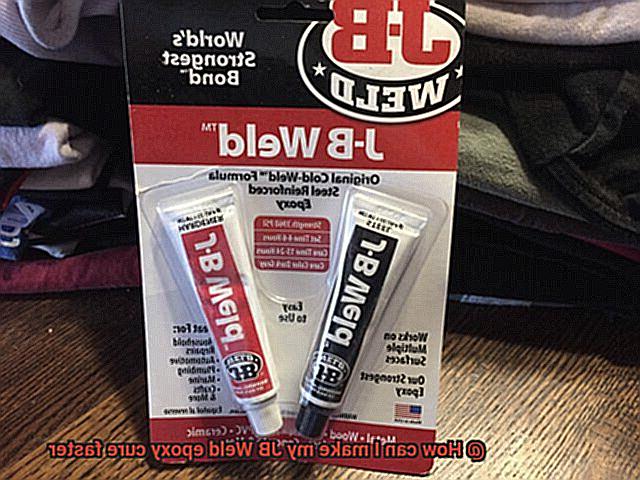
The mixing ratio is a make-or-break factor for proper curing. Stick to the manufacturer’s instructions and mix the resin and hardener precisely as recommended. Straying from these proportions can lead to incomplete or drawn-out curing. Take your time, measure accurately, and mix like a pro for an optimal bond.
Factor #3: Thickness of Application
Curiously enough, thickness matters when it comes to cure time. Thicker layers take longer to cure because the heat generated during the process needs to penetrate through each layer entirely. To speed things up, consider applying thinner layers of JB Weld Epoxy.
Factor #4: Humidity
Humidity levels have their say in how swiftly epoxy cures. High humidity slows things down, while low humidity revs things up. Aim for moderate humidity levels between 30% and 70% to create the perfect environment for optimal curing conditions.
Factor #5: Surface Preparation
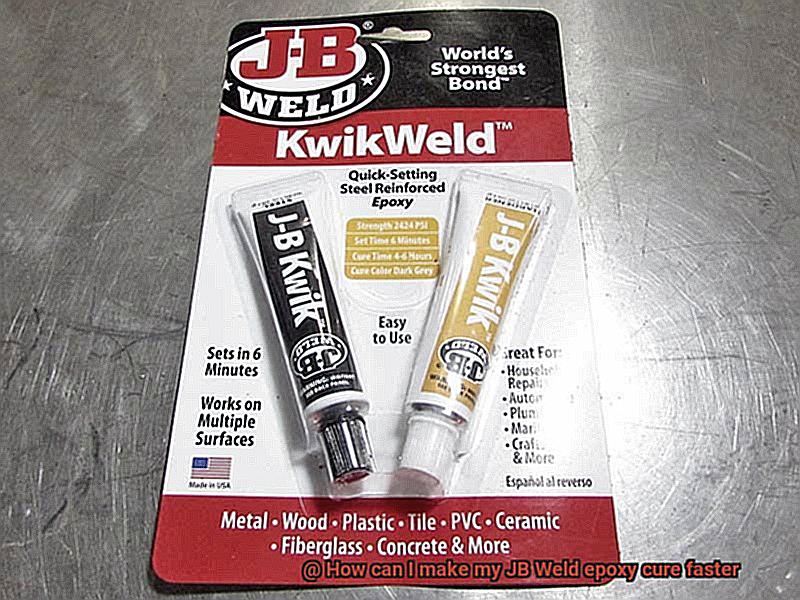
Before you dive into applying JB Weld Epoxy, prepare your surface meticulously. Cleanliness, dryness, and a lack of contaminants like oil, grease, or dust are vital for a strong bond and timely curing. Neglecting surface preparation can throw a wrench in the works and elongate the cure time.
Factor #6: Curing Time
Patience, my friends, is a virtue. Allow the recommended curing time for maximum bond strength. Rushing the process by using the bonded item prematurely can compromise the integrity and performance of the bond. Follow the manufacturer’s instructions and exercise patience for optimal results.
Increasing Temperature
We have the ultimate solution for you – increasing the temperature. That’s right, folks, by cranking up the heat, you can expedite the curing process of JB Weld epoxy and have your project completed in a jiffy.
But how does temperature impact glue, you ask? Allow me to elucidate. When JB Weld epoxy meets higher temperatures, it’s as if an adrenaline shot is injected into its chemical reactions. It’s like turbocharging your glue. And the outcome? Faster curing and a bond that’s stronger than ever.
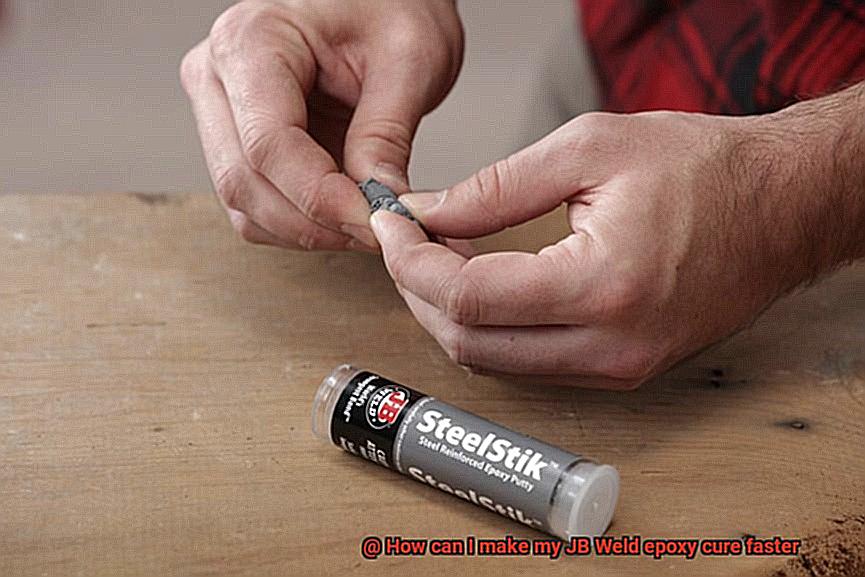
Now, let’s explore some thrilling ways to harness the power of temperature and put your glue on the fast track to success:
- Heat gun or hairdryer: Unleash a stream of hot air onto the epoxy to raise its temperature and supercharge curing. Proceed with caution, though – too much heat can lead to unsightly bubbling or cracking.
- Heat lamp or heating pad: Nestle your project near a cozy heat source to create a snug environment. This will maintain a consistent temperature and propel faster curing. Just keep an eye on that thermometer and avoid overheating – no scorching allowed.
- Oven magic: For smaller projects, perform a little oven wizardry. Pop them inside at a low temperature (around 150-200 degrees Fahrenheit). Voila. The curing process will be expedited like never before. But remember, always consult the manufacturer’s instructions before embarking on this daring endeavor.
However, be aware – increasing the temperature may reduce the working time of the epoxy. Time will be of the essence once that glue is mixed and ready to go. No time for dilly-dallying.
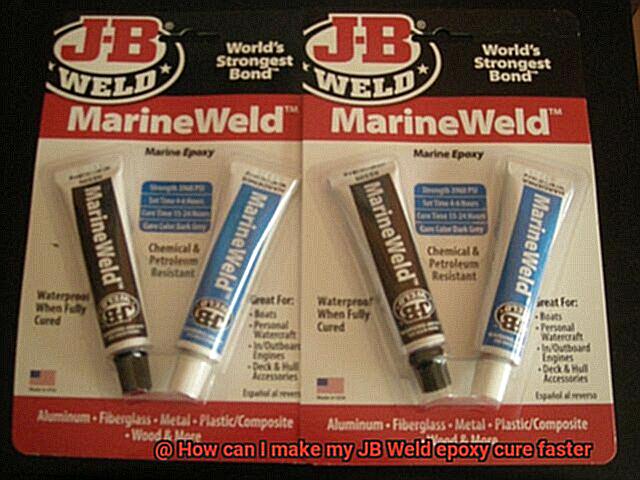
Mixing Resin and Hardener in the Correct Ratio
Imagine this: you’re embarking on a DIY project, armed with JB Weld epoxy resin and hardener. But there’s one crucial step you can’t afford to overlook – mixing them in the correct ratio. This may seem like a small detail, but let me assure you, it’s absolutely vital.
So, why is it so important to mix JB Weld epoxy resin and hardener in the correct ratio? Well, my friend, it all comes down to achieving optimal strength and ensuring that your epoxy cures properly. If you don’t get the ratio right, you could end up with a weak bond that won’t hold up over time.
Now, let’s break down how to mix resin and hardener in the correct ratio. First things first, gather your materials. You’ll need equal parts of JB Weld epoxy resin and hardener. These components are usually found in separate tubes, so make sure to squeeze out equal amounts of both.
To ensure accurate measurement, I recommend using measuring cups or syringes specifically designed for epoxy resin mixing. These specialized tools will help you achieve precise measurements and prevent any imbalances in the resin and hardener ratio.
Once you have measured equal amounts of resin and hardener, transfer them into a clean mixing container. It’s crucial to use a clean container to avoid any contaminants that could affect the curing process.
Now comes the fun part – stirring. Thoroughly mix the resin and hardener together until you have a consistent mixture with no streaks or swirls of either component visible. Pay attention to the recommended mixing time mentioned on the packaging or instructions. Over-mixing or under-mixing can influence the curing process and result in an improper bond.
Keep in mind that some epoxy products may require a specific mixing technique, such as stirring in a particular pattern or using a specific tool. Be sure to follow these instructions for optimal results.
Temperature can also play a role in the curing time of JB Weld epoxy. Higher temperatures generally accelerate the curing process, while colder temperatures slow it down. If you’re looking to speed up the curing process, consider working in a warmer environment.
Once you have mixed the resin and hardener in the correct ratio, it’s time to apply the epoxy to your desired surface promptly. The curing process will start as soon as the components are mixed, so make sure you have everything ready before you begin mixing.
Reducing Viscosity
Viscosity, the measure of a substance’s thickness or flowability, plays a crucial role in epoxy applications. For those seeking to accelerate their projects, reducing epoxy viscosity is key. Luckily, there are several techniques that can be employed to achieve this.
One effective method is heating the epoxy resin and hardener mixture. By gently warming the mixture, its viscosity decreases, resulting in a faster curing time. However, caution must be exercised to avoid overheating. Following the manufacturer’s instructions on temperature limits ensures that the epoxy doesn’t cure too quickly or become unusable.
Another approach is to mix the epoxy with a compatible solvent such as acetone or denatured alcohol. Adding a solvent thins out the epoxy, making it easier to apply and accelerating the curing process. It’s essential to choose a solvent that harmonizes with the specific epoxy formulation being used to prevent any adverse effects on the final result.
In addition, opting for thinner epoxy formulations can save valuable time. Some manufacturers offer low-viscosity or fast-curing options that naturally have lower viscosity. These formulations expedite the curing process effortlessly.
Furthermore, proper mixing techniques are essential in reducing viscosity and promoting faster curing. Thoroughly mixing the epoxy resin and hardener according to the manufacturer’s instructions ensures even distribution of both components throughout the mixture. This consistency enhances flowability and leads to quicker curing.
Lastly, applying epoxy in thin layers significantly reduces viscosity and accelerates curing time. Thicker applications take longer to cure due to the larger amount of material needing to react and harden. Conversely, applying thin coats minimizes mass and expedites overall curing.
Proper Surface Preparation
Are you ready to take your epoxy bonding game to the next level? Well, get ready, because I’m about to reveal the secret to a successful bond – proper surface preparation. Think of it as the superhero origin story for your epoxy, setting it up for a faster cure and a stronger hold. So, let’s dive into the captivating world of surface preparation and unlock the full potential of your JB Weld epoxy.
Cleanliness: The Foundation of a Solid Bond
Imagine trying to stick your superhero epoxy to a dirty surface – it’s like trying to save the day while wearing a villain’s cape. Don’t let that happen. Grab a mild detergent or degreaser and give that area a good scrub. Wave goodbye to dirt, grease, and oil because they are the sworn enemies of adhesion. A clean slate is essential for a bond that won’t let you down.
Dryness: Banishing Moisture, the Kryptonite of Epoxy
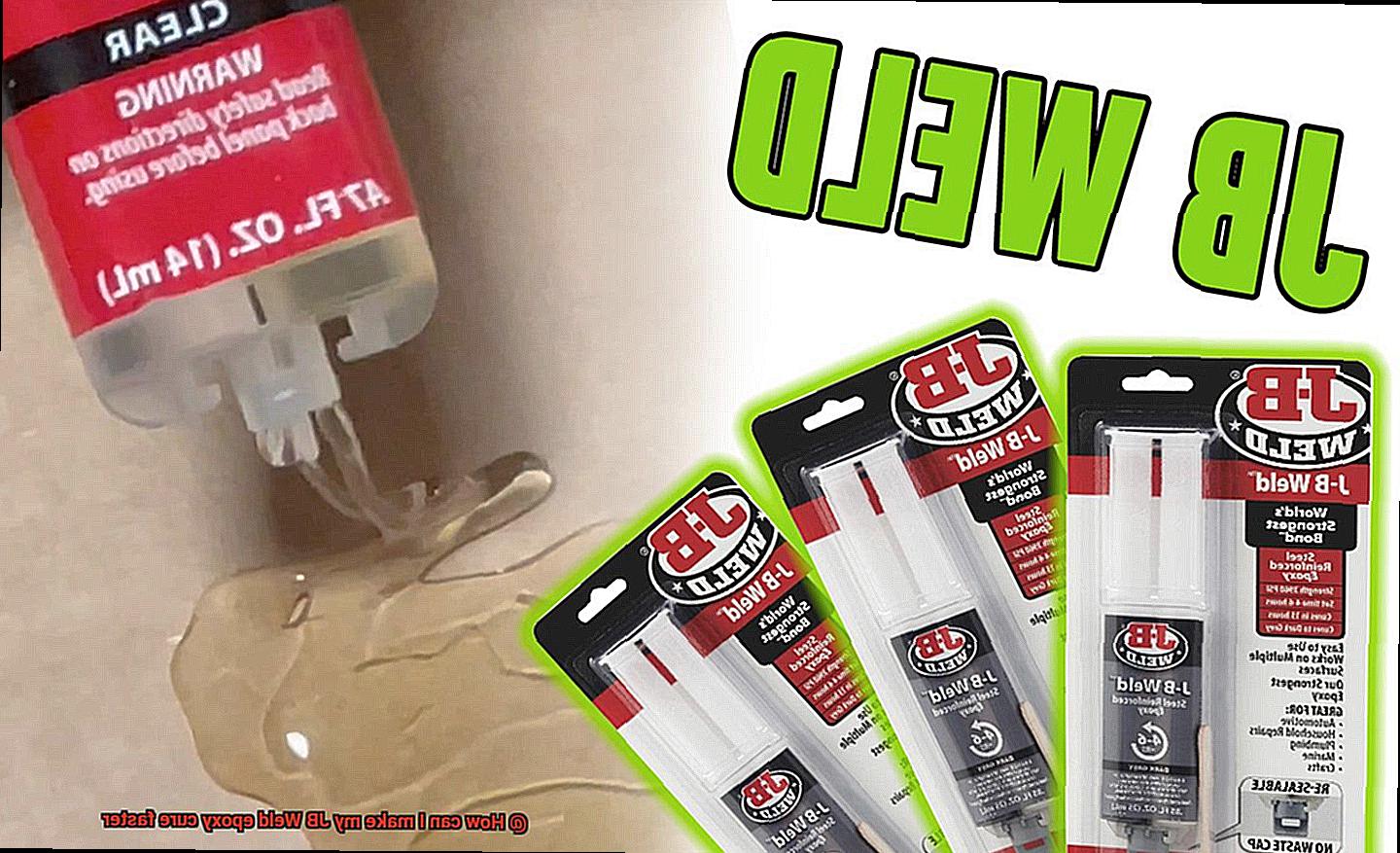
Moisture is like kryptonite to epoxy curing properly. Any lingering moisture can weaken the bond and leave you with a less-than-super result. So, after your heroic cleaning mission, make sure to dry the surface thoroughly. Use a clean cloth or let the surface air dry naturally – just make sure it’s bone dry before moving on to the next step.
Roughening Up: Giving Your Epoxy Something to Grip Onto
To level up your surface preparation game, roughen it up a bit. Think of it as giving your epoxy something to grip onto, just like Spiderman clinging to a wall. Grab some fine-grit sandpaper or a wire brush and create a slightly rough texture. This provides more surface area for the epoxy to adhere to, ensuring a strong bond that won’t let you down.
Eliminating Villains: Removing Loose Paint, Rust, and Coatings
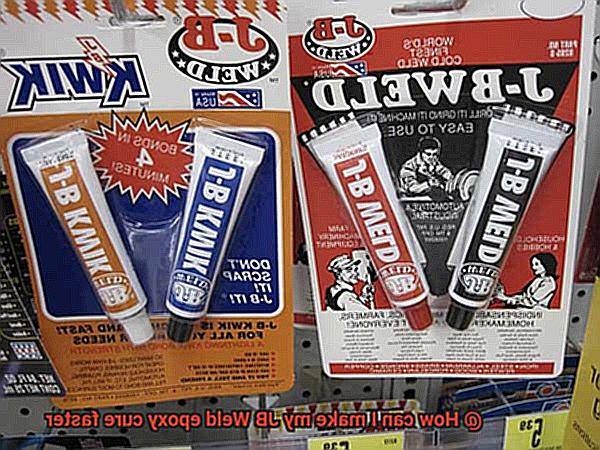
Before you apply the epoxy, make sure there’s no loose paint, rust, or other coatings hanging around. They can be like villains plotting against your superhero epoxy bond. Use a scraper or sandpaper to remove these enemies of adhesion and give your epoxy a clear path to success.
The Sidekick: Following the Manufacturer’s Instructions
One last thing – always read and follow the manufacturer’s instructions. They’re like the trusty sidekick guiding you through the process. Different epoxies may have specific requirements for surface preparation and application. Following these instructions will save the day, ensuring your epoxy cures faster and delivers super-strong bonds.
Allowing Enough Curing Time
Curing time is a critical factor when it comes to achieving the strongest and most durable bond with JB Weld epoxy. This two-part adhesive relies on a chemical reaction between its resin and hardener components to transform from a liquid mixture into a rock-solid bond. So, why is curing time so important? Well, my fellow glue enthusiasts, it’s all about ensuring the longevity and reliability of your project.
When you don’t give JB Weld enough time to cure, you risk compromising the strength and durability of the bond. And let’s face it, nobody wants their hard work to fall apart. That’s why patience is key in this process. Allow nature to work its magic and give JB Weld the time it needs.
Now, you might be wondering how long this curing process takes. Well, my adhesive aficionados, it depends on various factors like temperature, humidity, and the specific JB Weld product you’re using. As a general rule of thumb, JB Weld takes approximately 4-6 hours to set and a solid 15-24 hours to fully cure at room temperature (around 25°C or 77°F). But remember, these are just rough estimates – your individual circumstances may vary.
Temperature plays a significant role in the curing process. While you may be tempted to crank up the heat for faster results, don’t do it. Rushing the curing process by applying excessive heat or force can compromise the final strength and integrity of your bond. Trust me on this one – patience is your secret weapon.
To ensure optimal results, always follow the manufacturer’s instructions regarding curing time. Don’t cut corners; give JB Weld the time it needs to work its magic. Rushing things might lead to weak bonds or even failure down the road – and that’s not what we want, is it?
Remember to properly prepare your surfaces, eliminate moisture, roughen things up for better adhesion, and remove any loose paint or coatings. And most importantly, be patient and give JB Weld the time it needs to cure. Trust me, your projects will thank you later.
aDtfv_6DyYw” >
Conclusion
Speeding up the curing process of JB Weld epoxy is a common desire among DIY enthusiasts and professionals alike. Fortunately, there are several techniques you can employ to make your epoxy cure faster. Let’s explore these methods in detail to help you get your project completed in no time.
One effective way to accelerate the curing time is by applying heat. Heat helps to activate the chemical reaction that causes the epoxy to harden. You can use a heat gun or a hairdryer set on low heat to gently warm the epoxy surface. Be cautious not to overheat it, as excessive heat can cause bubbling or warping.
Another method is using an accelerator or catalyst specifically designed for JB Weld epoxy. These substances are added directly to the epoxy mixture and work by increasing the speed of the curing process. They are readily available at hardware stores and can significantly reduce curing time.
Properly preparing the surfaces prior to applying JB Weld epoxy is crucial for achieving faster curing times. Make sure both surfaces are clean, dry, and free from any contaminants such as grease or oil. Roughening the surface with sandpaper can also enhance adhesion and promote quicker curing.
Additionally, adjusting the ratio of resin to hardener can affect curing time. Increasing the amount of hardener relative to resin will expedite the curing process. However, be mindful not to deviate too much from the recommended mixing ratios, as this may compromise the overall strength and durability of the bond.
Lastly, creating an optimal environment for curing can make a significant difference in speed. Ensure that you’re working in a well-ventilated area with moderate temperature and low humidity levels. Proper ventilation allows any fumes emitted during curing to dissipate quickly, while favorable temperature and humidity conditions encourage faster chemical reactions.
In conclusion, if you’re looking for ways to make your JB Weld epoxy cure faster, consider employing techniques such as applying heat, using accelerators or catalysts, preparing surfaces adequately, adjusting the resin-to-hardener ratio, and creating an optimal curing environment.

